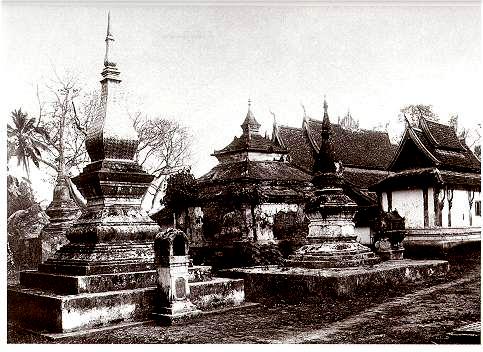|
||||||||||||
|
||||||||||||
| Situated at the confluence
of the Mekong and the Nam Khane, Vat Xieng Thong is the largest and oldest of the
monasteries in Luang Prabang. Its history is linked to the legend of the founding of the town. According to tradition, two hermits settled near a striking mai thong tree which became the site of the future kingdom. A betel-nut trader from Vientiane, chosen for his intrinsic merit by the people, became the first monarch of the kingdom. Under the name of Phagna Chanthaphanit Sathit Souvannaphouma, he ordered the construction of the royal palace and the first monastery at the site indicate by the two hermits. Contrary to this legend, local annals mention that Vat Xieng Thong was built by King Saya Setthathirath in 1560. It was the only monastery to escape the 1887 fire, at the time of the sacking of Luang Prabang. Vat Xieng Thong was restored twice - in 1928 and then again between 1952 and 1960 under the rule of King Sisavong Vong. The viharn was conceived as a development of the plain type, with three naves and a single porch. It is set apart from other monasteries by the harmonious lines of its superposed roofs that are more flared than usual. The central spike of the roof has seventeen Prasat and the horns of the ridge-tiles portray naga heads. The last large-scale restoration was carried out on the decoration and the construction of a funerary chapel; work upon which began in 1962. Both sides of the interior walls have been decorated with gold stenciled designs on a black background. Antique paintings on red backgrounds have been preserved along the southern side of the Western section. On the rear wall, the original features of the glass mosaic decorations have been kept intact and completely refurbished. Above the pillar capital, illustrated images of Buddha and a stupa portray his descent from the sky with the 33 gods. Below the capital is a representation of the Mai Thong tree, in memory of the two hermits who demarcated the site of the future kingdom. |
||||||||||||
SEAsite Laos | Overview | History | Art & Culture | Language | Literature |
||||||||||||
Gallery | Folklore | Other Topics | Links | SEAsite |
||||||||||||
|
2003 SEAsite
Laos. Treasures of Luang Prabang |
||||||||||||
